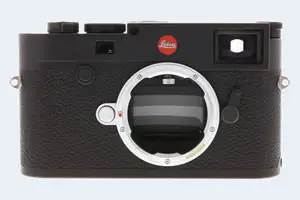Leica M10 vs Sony HX400V
The Leica M10 (Typ 3656) and the Sony Cyber-shot DSC-HX400V are two digital cameras that were announced, respectively, in January 2017 and February 2014. The M10 is a rangefinder-focusing mirrorless camera, while the HX400V is a fixed lens compact. The cameras are based on a full frame (M10) and a 1/2.3-inch (HX400V) sensor. The Leica has a resolution of 23.8 megapixels, whereas the Sony provides 20.2 MP.
Below is an overview of the main specs of the two cameras as a starting point for the comparison.

Check M10 offers at
ebay.com

Check HX400V offers at
ebay.com
Going beyond this snapshot of core features and characteristics, what are the differences between the Leica M10 (Typ 3656) and the Sony Cyber-shot DSC-HX400V? Which one should you buy? Read on to find out how these two cameras compare with respect to their body size, their imaging sensors, their shooting features, their input-output connections, and their reception by expert reviewers.
Body comparison
An illustration of the physical size and weight of the Leica M10 and the Sony HX400V is provided in the side-by-side display below. The two cameras are presented according to their relative size. Three consecutive perspectives from the front, the top, and the back are available. All width, height and depth measures are rounded to the nearest millimeter.
The M10 can be obtained in two different colors (black, silver), while the HX400V is only available in black.
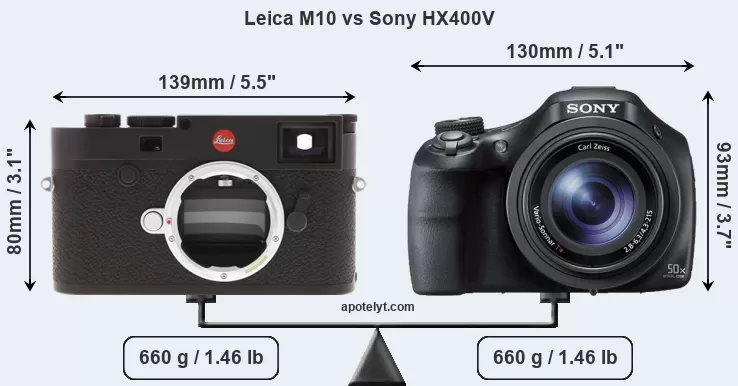
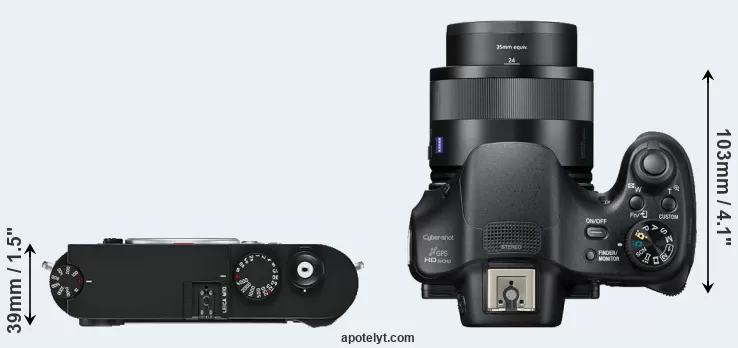
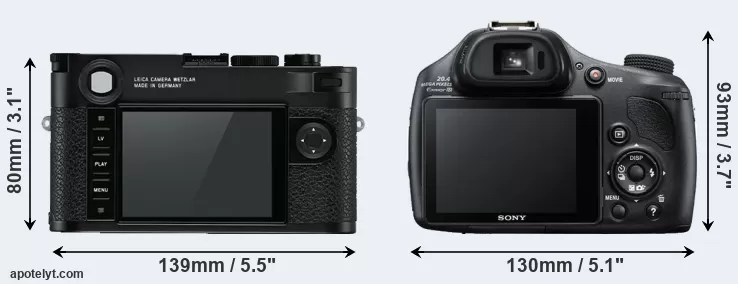
If the front view area (width x height) of the cameras is taken as an aggregate measure of their size, the Sony HX400V is notably larger (9 percent) than the Leica M10. Yet, the two cameras share the same weight. It is worth mentioning in this context that the M10 is splash and dust resistant, while the HX400V does not feature any corresponding weather-sealing.
The above size and weight comparisons are to some extent incomplete and possibly misleading, as the HX400V has a lens built in, whereas the M10 is an interchangeable lens camera that requires a separate lens. Attaching the latter will add extra weight and bulk to the setup. You can compare the optics available for the M10 and their specifications in the Leica M Lens Catalog.
Concerning battery life, the M10 gets 210 shots out of its Leica BP-SCL5 battery, while the HX400V can take 300 images on a single charge of its Sony NP-BX1 power pack.
The adjacent table lists the principal physical characteristics of the two cameras alongside a wider set of alternatives. In case you want to display and compare another camera duo, you can use the CAM-parator app to select your camera combination among a large number of options.

| Camera Model |
Camera Width |
Camera Height |
Camera Depth |
Camera Weight |
Battery Life |
Weather Sealing |
Camera Launch |
Launch Price (USD) |
Street Price |
||
|---|---|---|---|---|---|---|---|---|---|---|---|
| 1. | Leica M10 | 139 mm | 80 mm | 39 mm | 660 g | 210 | Y | Jan 2017 | 6,595 | ebay.com | |
| 2. | Sony HX400V | 130 mm | 93 mm | 103 mm | 660 g | 300 | n | Feb 2014 | 499 | ebay.com | |
| 3. | Canon 1D X Mark II | 158 mm | 168 mm | 83 mm | 1530 g | 1210 | Y | Feb 2016 | 5,999 | ebay.com | |
| 4. | Canon 6D Mark II | 144 mm | 111 mm | 75 mm | 765 g | 1200 | Y | Jun 2017 | 1,999 | amazon.com | |
| 5. | Canon SX60 | 128 mm | 93 mm | 114 mm | 650 g | 340 | n | Sep 2014 | 549 | ebay.com | |
| 6. | Leica M Typ 240 | 139 mm | 80 mm | 42 mm | 680 g | 500 | Y | Sep 2012 | 6,950 | ebay.com | |
| 7. | Leica M-E Typ 240 | 139 mm | 80 mm | 42 mm | 680 g | 500 | Y | Jun 2019 | 3,999 | ebay.com | |
| 8. | Leica M Typ 262 | 139 mm | 80 mm | 42 mm | 680 g | 400 | Y | Nov 2015 | 5,195 | ebay.com | |
| 9. | Leica M10-P | 139 mm | 80 mm | 39 mm | 660 g | 210 | Y | Aug 2018 | 7,995 | ebay.com | |
| 10. | Leica M11 | 139 mm | 80 mm | 39 mm | 640 g | 700 | Y | Jan 2022 | 8,995 | amazon.com | |
| 11. | Leica Q Typ 116 | 130 mm | 80 mm | 93 mm | 640 g | 300 | n | Jun 2015 | 4,249 | ebay.com | |
| 12. | Leica SL | 147 mm | 104 mm | 39 mm | 847 g | 400 | Y | Oct 2015 | 7,450 | ebay.com | |
| 13. | Nikon D5 | 160 mm | 159 mm | 92 mm | 1415 g | 3780 | Y | Jan 2016 | 6,499 | ebay.com | |
| 14. | Sony H300 | 128 mm | 89 mm | 92 mm | 590 g | 350 | n | Feb 2014 | 219 | ebay.com | |
| 15. | Sony H400 | 130 mm | 95 mm | 122 mm | 628 g | 300 | n | Feb 2014 | 319 | ebay.com | |
| 16. | Sony HX90V | 102 mm | 58 mm | 36 mm | 245 g | 360 | n | Apr 2015 | 429 | ebay.com | |
| 17. | Sony HX350 | 130 mm | 93 mm | 103 mm | 652 g | 300 | n | Dec 2016 | 449 | ebay.com | |
| Note: Measurements and pricing do not include easily detachable parts, such as add-on or interchangeable lenses or optional viewfinders. | |||||||||||
Any camera decision will obviously take relative prices into account. The manufacturer’s suggested retail prices give an idea on the placement of the camera in the maker’s lineup and the broader market. The HX400V was launched at a lower price than the M10, despite having a lens built in. Normally, street prices remain initially close to the MSRP, but after a couple of months, the first discounts appear. Later in the product cycle and, in particular, when the replacement model is about to appear, further discounting and stock clearance sales often push the camera price considerably down. Then, after the new model is out, very good deals can frequently be found on the pre-owned market.
Sensor comparison
The size of the sensor inside a digital camera is one of the key determinants of image quality. All other things equal, a large sensor will have larger individual pixel-units that offer better low-light sensitivity, wider dynamic range, and richer color-depth than smaller pixels in a sensor of the same technological generation. Moreover, a large sensor camera will give the photographer more control over depth-of-field in the image and, thus, the ability to better isolate a subject from the background. On the downside, larger sensors tend to be more expensive and lead to bigger and heavier cameras and lenses.
Of the two cameras under consideration, the Leica M10 features a full frame sensor and the Sony HX400V a 1/2.3-inch sensor. The sensor area in the HX400V is 97 percent smaller. As a result of these sensor size differences, the cameras have a format factor of, respectively, 1.0 and 5.6. The sensor in the M10 has a native 3:2 aspect ratio, while the one in the HX400V offers a 4:3 aspect.
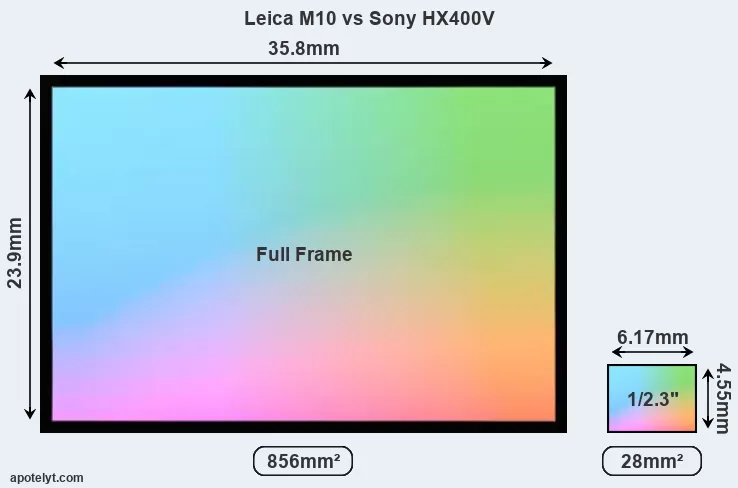
With 23.8MP, the M10 offers a higher resolution than the HX400V (20.2MP), but the M10 nevertheless has larger individual pixels (pixel pitch of 6.00μm versus 1.18μm for the HX400V) due to its larger sensor. Moreover, the M10 is a much more recent model (by 2 years and 11 months) than the HX400V, and its sensor will have benefitted from technological advances during this time that further enhance the light gathering capacity of its pixels. Coming back to sensor resolution, it should be mentioned that neither of the two cameras has an anti-alias filter installed, so they are able to capture all the detail the sensor resolves.
The resolution advantage of the Leica M10 implies greater flexibility for cropping images or the possibility to print larger pictures. The maximum print size of the M10 for good quality output (200 dots per inch) amounts to 29.8 x 20 inches or 75.6 x 50.7 cm, for very good quality (250 dpi) 23.8 x 16 inches or 60.5 x 40.6 cm, and for excellent quality (300 dpi) 19.8 x 13.3 inches or 50.4 x 33.8 cm. The corresponding values for the Sony HX400V are 25.9 x 19.4 inches or 65.8 x 49.4 cm for good quality, 20.7 x 15.6 inches or 52.7 x 39.5 cm for very good quality, and 17.3 x 13 inches or 43.9 x 32.9 cm for excellent quality prints.
The Leica M10 (Typ 3656) has a native sensitivity range from ISO 100 to ISO 50000. The corresponding ISO settings for the Sony Cyber-shot DSC-HX400V are ISO 80 to ISO 3200, with the possibility to increase the ISO range to 80-12800.
In terms of underlying technology, the M10 is build around a CMOS sensor, while the HX400V uses a BSI-CMOS imager. Both cameras use a Bayer filter for capturing RGB colors on a square grid of photosensors. This arrangement is found in most digital cameras.
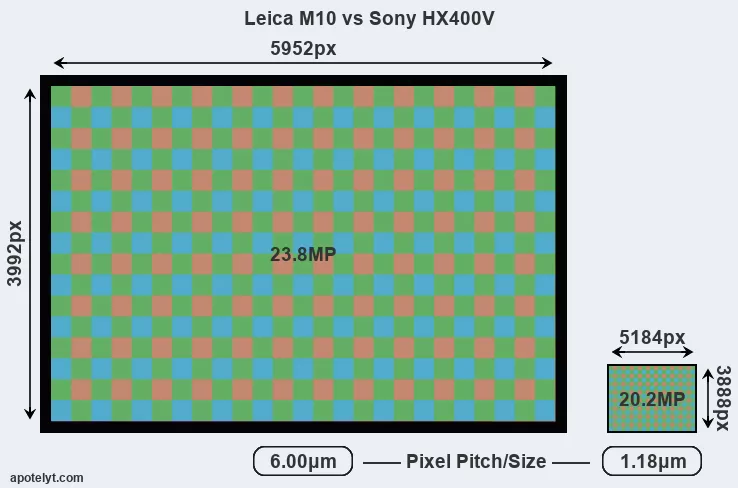
Consistent information on actual sensor performance is available from DXO Mark for many cameras. This service assesses and scores the color depth ("DXO Portrait"), dynamic range ("DXO Landscape"), and low-light sensitivity ("DXO Sports") of camera sensors, and also publishes an overall camera score. The table below summarizes the physical sensor characteristics and sensor quality findings and compares them across a set of similar cameras.

| Camera Model |
Sensor Class |
Resolution (MP) |
Horiz. Pixels |
Vert. Pixels |
Video Format |
DXO Portrait |
DXO Landscape |
DXO Sports |
DXO Overall |
||
|---|---|---|---|---|---|---|---|---|---|---|---|
| 1. | Leica M10 | Full Frame | 23.8 | 5952 | 3992 | none | 24.4 | 13.2 | 2133 | 86 | |
| 2. | Sony HX400V | 1/2.3 | 20.2 | 5184 | 3888 | 1080/60p | 20.1 | 11.4 | 629 | 45 | |
| 3. | Canon 1D X Mark II | Full Frame | 20.0 | 5472 | 3648 | 4K/60p | 24.1 | 13.5 | 3207 | 88 | |
| 4. | Canon 6D Mark II | Full Frame | 26.0 | 6240 | 4160 | 1080/60p | 24.4 | 11.9 | 2862 | 85 | |
| 5. | Canon SX60 | 1/2.3 | 14.2 | 4608 | 3072 | 1080/60p | 19.2 | 10.8 | 127 | 39 | |
| 6. | Leica M Typ 240 | Full Frame | 23.7 | 5952 | 3976 | 1080/25p | 24.0 | 13.3 | 1860 | 84 | |
| 7. | Leica M-E Typ 240 | Full Frame | 23.7 | 5952 | 3976 | 1080/25p | 25.2 | 14.2 | 2821 | 94 | |
| 8. | Leica M Typ 262 | Full Frame | 23.7 | 5952 | 3976 | none | 24.8 | 13.7 | 2478 | 90 | |
| 9. | Leica M10-P | Full Frame | 23.8 | 5952 | 3992 | none | 25.1 | 14.1 | 2739 | 93 | |
| 10. | Leica M11 | Full Frame | 60.3 | 9528 | 6328 | none | 26.3 | 14.8 | 3376 | 100 | |
| 11. | Leica Q Typ 116 | Full Frame | 24.0 | 6000 | 4000 | 1080/60p | 24.3 | 12.7 | 2221 | 85 | |
| 12. | Leica SL | Full Frame | 24.0 | 6000 | 4000 | 4K/30p | 25.0 | 13.4 | 1821 | 88 | |
| 13. | Nikon D5 | Full Frame | 20.7 | 5588 | 3712 | 4K/30p | 25.1 | 12.3 | 2343 | 88 | |
| 14. | Sony H300 | 1/2.3 | 19.9 | 5152 | 3864 | 720/30p | 20.1 | 11.4 | 630 | 45 | |
| 15. | Sony H400 | 1/2.3 | 19.9 | 5152 | 3864 | 720/30p | 20.1 | 11.4 | 630 | 45 | |
| 16. | Sony HX90V | 1/2.3 | 18.0 | 4896 | 3672 | 1080/60p | 20.2 | 11.6 | 738 | 47 | |
| 17. | Sony HX350 | 1/2.3 | 19.9 | 5152 | 3864 | 1080/60p | 20.5 | 11.9 | 896 | 49 | |
| Note: DXO values in italics represent estimates based on sensor size and age. | |||||||||||
Many modern cameras are not only capable of taking still images, but can also record movies. The HX400V indeed provides for movie recording, while the M10 does not. The highest resolution format that the HX400V can use is 1080/60p.
Feature comparison
Beyond body and sensor, cameras can and do differ across a range of features. For example, the HX400V has an electronic viewfinder (210k dots), while the M10 has an optical one. Both systems have their advantages, with the electronic viewfinder making it possible to project supplementary shooting information into the framing view, whereas the optical viewfinder offers lag-free viewing and a very clear framing image. The table below summarizes some of the other core capabilities of the Leica M10 and Sony HX400V in connection with corresponding information for a sample of similar cameras.

| Camera Model |
Viewfinder (Type or 000 dots) |
Control Panel (yes/no) |
LCD Specifications (inch/000 dots) |
LCD Attach- ment |
Touch Screen (yes/no) |
Max Shutter Speed * |
Max Shutter Flaps * |
Built-in Flash (yes/no) |
Built-in Image Stab |
||
|---|---|---|---|---|---|---|---|---|---|---|---|
| 1. | Leica M10 | optical | n | 3.0 / 1037 | fixed | n | 1/4000s | 5.0/s | n | n | |
| 2. | Sony HX400V | 210 | n | 3.0 / 921 | tilting | n | 1/4000s | 10.0/s | Y | Y | |
| 3. | Canon 1D X Mark II | optical | Y | 3.2 / 1620 | fixed | Y | 1/8000s | 16.0/s | n | n | |
| 4. | Canon 6D Mark II | optical | Y | 3.0 / 1040 | swivel | Y | 1/4000s | 6.5/s | n | n | |
| 5. | Canon SX60 | 922 | n | 3.0 / 922 | swivel | n | 1/2000s | 6.4/s | Y | Y | |
| 6. | Leica M Typ 240 | optical | n | 3.0 / 920 | fixed | n | 1/4000s | 3.0/s | n | n | |
| 7. | Leica M-E Typ 240 | optical | n | 3.0 / 920 | fixed | n | 1/4000s | 3.0/s | n | n | |
| 8. | Leica M Typ 262 | optical | n | 3.0 / 921 | fixed | n | 1/4000s | 3.0/s | n | n | |
| 9. | Leica M10-P | optical | n | 3.0 / 1037 | fixed | Y | 1/4000s | 5.0/s | n | n | |
| 10. | Leica M11 | optical | n | 3.0 / 2333 | fixed | Y | 1/4000s | 4.5/s | n | n | |
| 11. | Leica Q Typ 116 | 3680 | n | 3.0 / 1040 | fixed | Y | 1/2000s | 10.0/s | n | Y | |
| 12. | Leica SL | 4400 | Y | 3.0 / 1040 | fixed | Y | 1/8000s | 11.0/s | n | n | |
| 13. | Nikon D5 | optical | Y | 3.2 / 2359 | fixed | Y | 1/8000s | 14.0/s | n | n | |
| 14. | Sony H300 | none | n | 3.0 / 460 | fixed | n | 1/1500s | 0.8/s | Y | Y | |
| 15. | Sony H400 | 210 | n | 3.0 / 460 | fixed | n | 1/2000s | 0.7/s | Y | Y | |
| 16. | Sony HX90V | 638 | n | 3.0 / 921 | tilting | n | 1/2000s | 10.0/s | Y | Y | |
| 17. | Sony HX350 | 202 | n | 3.0 / 922 | tilting | n | 1/4000s | 10.0/s | Y | Y | |
| Note: *) Information refers to the mechanical shutter, unless the camera only has an electronic one. | |||||||||||
One difference between the cameras concerns the presence of an on-board flash. The HX400V has one, while the M10 does not. While the built-in flash of the HX400V is not very powerful, it can at times be useful as a fill-in light.
The Leica M10 has an intervalometer built-in. This enables the photographer to capture time lapse sequences, such as flower blooming, a sunset or moon rise, without purchasing an external camera trigger and related software.
The M10 writes its imaging data to SDXC cards, while the HX400V uses SDXC or Memory Stick PRO Duo cards. The M10 supports UHS-I cards (Ultra High Speed data transfer of up to 104 MB/s), while the HX400V cannot take advantage of Ultra High Speed SD cards.
Connectivity comparison
For some imaging applications, the extent to which a camera can communicate with its environment can be an important aspect in the camera decision process. The table below provides an overview of the connectivity of the Leica M10 (Typ 3656) and Sony Cyber-shot DSC-HX400V and, in particular, the interfaces the cameras (and selected comparators) provide for accessory control and data transfer.

| Camera Model |
Hotshoe Port |
Internal Mic / Speaker |
Microphone Port |
Headphone Port |
HDMI Port |
USB Port |
WiFi Support |
NFC Support |
Bluetooth Support |
||
|---|---|---|---|---|---|---|---|---|---|---|---|
| 1. | Leica M10 | Y | - / - | - | - | - | - | Y | - | - | |
| 2. | Sony HX400V | Y | stereo / mono | - | - | micro | 2.0 | Y | Y | - | |
| 3. | Canon 1D X Mark II | Y | mono / mono | Y | Y | mini | 3.0 | - | - | - | |
| 4. | Canon 6D Mark II | Y | stereo / mono | Y | - | mini | 2.0 | Y | Y | Y | |
| 5. | Canon SX60 | Y | stereo / mono | Y | - | mini | 2.0 | Y | Y | - | |
| 6. | Leica M Typ 240 | Y | stereo / mono | - | - | - | 2.0 | - | - | - | |
| 7. | Leica M-E Typ 240 | Y | mono / - | - | - | - | 2.0 | - | - | - | |
| 8. | Leica M Typ 262 | Y | - / - | - | - | - | 2.0 | - | - | - | |
| 9. | Leica M10-P | Y | - / - | - | - | - | - | Y | - | - | |
| 10. | Leica M11 | Y | - / - | - | - | - | 3.2 | Y | - | Y | |
| 11. | Leica Q Typ 116 | Y | stereo / mono | - | - | micro | 2.0 | Y | Y | - | |
| 12. | Leica SL | Y | stereo / mono | Y | Y | full | 3.0 | Y | - | - | |
| 13. | Nikon D5 | Y | stereo / mono | Y | Y | mini | 3.0 | - | - | - | |
| 14. | Sony H300 | - | mono / mono | - | - | micro | 2.0 | Y | - | - | |
| 15. | Sony H400 | - | mono / mono | - | - | micro | 2.0 | Y | - | - | |
| 16. | Sony HX90V | - | stereo / mono | - | - | micro | 2.0 | Y | Y | - | |
| 17. | Sony HX350 | - | stereo / mono | - | - | micro | 2.0 | - | - | - |
Travel and landscape photographers will find it useful that the HX400V has an internal geolocalization sensor and can record GPS coordinates in its EXIF data.
Both the M10 and the HX400V have been discontinued, but can regularly be found used on ebay. The M10 was replaced by the Leica M11, while the HX400V does not have a direct successor. Further information on the features and operation of the M10 and HX400V can be found, respectively, in the Leica M10 Manual (free pdf) or the online Sony HX400V Manual.
Review summary
So how do things add up? Is there a clear favorite between the Leica M10 and the Sony HX400V? Which camera is better? The listing below highlights the relative strengths of the two models.

Reasons to prefer the Leica M10 (Typ 3656):
- More detail: Offers more megapixels (23.8 vs 20.2MP) with a 11% higher linear resolution.
- Better image quality: Features a larger and more technologically advanced imaging sensor.
- Richer colors: The sensor size advantage translates into images with better, more accurate colors.
- More dynamic range: Larger sensor captures a wider spectrum of light and dark details.
- Better low-light sensitivity: Larger sensor produces good images even in poorly lit environments.
- Brighter framing: Features an optical viewfinder for clear, lag-free composition.
- More detailed LCD: Has a higher resolution rear screen (1037k vs 921k dots).
- Easier time-lapse photography: Has an intervalometer built-in for low frequency shooting.
- More flexible: Accepts interchangeable lenses, so that lens characteristics can be altered.
- Better sealing: Is weather sealed to enable shooting in dusty or wet environments.
- Faster buffer clearing: Has an SD card interface that supports the UHS-I standard.
- More prestigious: Has the Leica luxury appeal, which ensures a high resale price.
- More modern: Reflects 2 years and 11 months of technical progress since the HX400V launch.

Advantages of the Sony Cyber-shot DSC-HX400V:
- Broader imaging potential: Can capture not only stills but also 1080/60p video.
- More framing info: Has an electronic viewfinder that displays shooting data.
- More flexible LCD: Has a tilting screen for odd-angle shots in landscape orientation.
- Faster burst: Shoots at higher frequency (10 vs 5 flaps/sec) to capture the decisive moment.
- Ready to shoot: Has an integrated lens, whereas the M10 necessitates an extra lens.
- Longer lasting: Gets more shots (300 versus 210) out of a single battery charge.
- Sharper images: Has stabilization technology built-in to reduce the impact of hand-shake.
- Easier fill-in: Has a small integrated flash to brighten shadows of backlit subjects.
- Easier geotagging: Features an internal GPS sensor to log localization data.
- Easier device pairing: Supports NFC for fast wireless image transfer over short distances.
- More affordable: Was introduced at a lower price, despite coming with a built-in lens.
- More heavily discounted: Has been around for much longer (launched in February 2014).
If the number of relative strengths (bullet points above) is taken as a guide, the M10 comes out slightly ahead of the HX400V (13 : 12 points). However, the pertinence of the various camera strengths will differ across photographers, so that you might want to weigh individual camera traits according to their importance for your own imaging needs before making a camera decision. A professional wedding photographer will view the differences between cameras in a way that diverges from the perspective of a travel photog, and a person interested in cityscapes has distinct needs from a macro shooter. Hence, the decision which camera is best and worth buying is often a very personal one.
In any case, while the comparison of the spec-sheets of cameras can offer a general idea of their imaging potential, it remains incomplete and does no justice, for example, to the way the M10 or the HX400V perform in practice. At times, user reviews, such as those published at amazon, address these issues in a useful manner, but such feedback is on many occasions incomplete, inconsistent, and unreliable.
Expert reviews
This is where reviews by experts come in. The table below provides a synthesis of the camera assessments of some of the best known photo-gear review sites (amateurphotographer [AP], cameralabs [CL], digitalcameraworld [DCW], dpreview [DPR], ephotozine [EPZ], photographyblog [PB]). As can be seen, the professional reviewers agree in many cases on the quality of different cameras, but sometimes their assessments diverge, reinforcing the earlier point that a camera decision is often a very personal choice.

| Camera Model |
AP score |
CL score |
DCW score |
DPR score |
EPZ score |
PB score |
Camera Launch |
Launch Price (USD) |
Street Price |
||
|---|---|---|---|---|---|---|---|---|---|---|---|
| 1. | Leica M10 | 4.5/5 | .. | .. | .. | 4/5 | 4.5/5 | Jan 2017 | 6,595 | ebay.com | |
| 2. | Sony HX400V | 4/5 | + + | .. | .. | 4/5 | 4/5 | Feb 2014 | 499 | ebay.com | |
| 3. | Canon 1D X Mark II | .. | .. | 4.5/5 | 89/100 | 4.5/5 | 4.5/5 | Feb 2016 | 5,999 | ebay.com | |
| 4. | Canon 6D Mark II | 4/5 | + | 4/5 | 80/100 | 4.5/5 | 4/5 | Jun 2017 | 1,999 | amazon.com | |
| 5. | Canon SX60 | 3/5 | + + | .. | 75/100 | 4/5 | 4.5/5 | Sep 2014 | 549 | ebay.com | |
| 6. | Leica M Typ 240 | 4/5 | .. | .. | .. | 4/5 | .. | Sep 2012 | 6,950 | ebay.com | |
| 7. | Leica M-E Typ 240 | .. | .. | .. | .. | .. | .. | Jun 2019 | 3,999 | ebay.com | |
| 8. | Leica M Typ 262 | .. | .. | .. | .. | .. | .. | Nov 2015 | 5,195 | ebay.com | |
| 9. | Leica M10-P | .. | .. | 3/5 | .. | .. | 4/5 | Aug 2018 | 7,995 | ebay.com | |
| 10. | Leica M11 | 4.5/5 | .. | 4.5/5 | .. | 4.5/5 | 4.5/5 | Jan 2022 | 8,995 | amazon.com | |
| 11. | Leica Q Typ 116 | 5/5 | .. | .. | 80/100 | 4.5/5 | 4.5/5 | Jun 2015 | 4,249 | ebay.com | |
| 12. | Leica SL | 4/5 | .. | 4/5 | 84/100 | 4.5/5 | 4/5 | Oct 2015 | 7,450 | ebay.com | |
| 13. | Nikon D5 | .. | .. | 4/5 | 89/100 | 4.5/5 | 5/5 | Jan 2016 | 6,499 | ebay.com | |
| 14. | Sony H300 | .. | + | .. | .. | 4.5/5 | 4/5 | Feb 2014 | 219 | ebay.com | |
| 15. | Sony H400 | .. | o | .. | .. | 3.5/5 | 3.5/5 | Feb 2014 | 319 | ebay.com | |
| 16. | Sony HX90V | 4/5 | + + | .. | .. | 4/5 | 4.5/5 | Apr 2015 | 429 | ebay.com | |
| 17. | Sony HX350 | .. | .. | .. | .. | .. | 4/5 | Dec 2016 | 449 | ebay.com | |
| Note: (+ +) highly recommended; (+) recommended; (o) reviewed; (..) not available. | |||||||||||
The above review scores should be interpreted with care, though. The ratings were established in reference to similarly priced cameras that were available in the market at the time of the review. Hence, a score should always be seen in the context of the camera's market launch date and its price, and rating-comparisons among cameras that span long time periods or concern very differently equipped models make little sense. Also, kindly note that some of the listed sites have over time developped their review approaches and their reporting style.

Check M10 offers at
ebay.com

Check HX400V offers at
ebay.com
Other camera comparisons
Did this review help to inform your camera decision process? In case you would like to check on the differences and similarities of other camera models, just use the search menu below. As an alternative, you can also directly jump to any one of the listed comparisons that were previously generated by the CAM-parator tool.
- Canon 700D vs Leica M10
- Fujifilm GFX 50S II vs Leica M10
- Leica M10 vs Nikon D80
- Leica M10 vs Panasonic GF2
- Leica M10 vs Ricoh WG-6
- Leica M10 vs Sony RX1R II
- Nikon D3000 vs Sony HX400V
- Panasonic GF2 vs Sony HX400V
- Panasonic GF6 vs Sony HX400V
- Panasonic GH2 vs Sony HX400V
- Sony A1 vs Sony HX400V
- Sony HX400V vs Sony RX1R II
Specifications: Leica M10 vs Sony HX400V
Below is a side-by-side comparison of the specs of the two cameras to facilitate a quick review of their differences and common features.
| Camera Model | Leica M10 | Sony HX400V |
|---|---|---|
| Camera Type | Rangefinder camera | Fixed lens compact camera |
| Camera Lens | Leica M mount lenses | 24-1200mm f/2.8-6.3 |
| Launch Date | January 2017 | February 2014 |
| Launch Price | USD 6,595 | USD 499 |
| Sensor Specs | Leica M10 | Sony HX400V |
| Sensor Technology | CMOS | BSI-CMOS |
| Sensor Format | Full Frame Sensor | 1/2.3" Sensor |
| Sensor Size | 35.8 x 23.9 mm | 6.17 x 4.55 mm |
| Sensor Area | 855.62 mm2 | 28.0735 mm2 |
| Sensor Diagonal | 43 mm | 7.7 mm |
| Crop Factor | 1.0x | 5.6x |
| Sensor Resolution | 23.8 Megapixels | 20.2 Megapixels |
| Image Resolution | 5952 x 3992 pixels | 5184 x 3888 pixels |
| Pixel Pitch | 6.00 μm | 1.18 μm |
| Pixel Density | 2.78 MP/cm2 | 71.80 MP/cm2 |
| Moiré control | no AA filter | no AA filter |
| Movie Capability | no Video | 1080/60p Video |
| ISO Setting | 100 - 50,000 ISO | 80 - 3,200 ISO |
| ISO Boost | no Enhancement | 80 - 12,800 ISO |
| Image Processor | Maestro II | BIONZ X |
| DXO Sensor Quality (score) | 86 | .. |
| DXO Color Depth (bits) | 24.4 | .. |
| DXO Dynamic Range (EV) | 13.2 | .. |
| DXO Low Light (ISO) | 2133 | .. |
| Screen Specs | Leica M10 | Sony HX400V |
| Viewfinder Type | Optical viewfinder | Electronic viewfinder |
| Viewfinder Field of View | 100% | 100% |
| Viewfinder Magnification | 0.73x | |
| Viewfinder Resolution | 210k dots | |
| LCD Framing | Live View | Live View |
| Rear LCD Size | 3.0inch | 3.0inch |
| LCD Resolution | 1037k dots | 921k dots |
| LCD Attachment | Fixed screen | Tilting screen |
| Shooting Specs | Leica M10 | Sony HX400V |
| Focus System | Manual Focus | Contrast-detect AF |
| Manual Focusing Aid | Focus Peaking | no Peaking Feature |
| Continuous Shooting | 5 shutter flaps/s | 10 shutter flaps/s |
| Time-Lapse Photography | Intervalometer built-in | no Intervalometer |
| Fill Flash | no On-Board Flash | Built-in Flash |
| Storage Medium | SDXC cards | MS or SDXC cards |
| Single or Dual Card Slots | Single card slot | Single card slot |
| UHS card support | UHS-I | no |
| Connectivity Specs | Leica M10 | Sony HX400V |
| External Flash | Hotshoe | Hotshoe |
| USB Connector | no USB | USB 2.0 |
| HDMI Port | no HDMI | micro HDMI |
| Wifi Support | Wifi built-in | Wifi built-in |
| Near-Field Communication | no NFC | NFC built-in |
| Geotagging | no internal GPS | GPS built-in |
| Body Specs | Leica M10 | Sony HX400V |
| Environmental Sealing | Weathersealed body | not weather sealed |
| Battery Type | Leica BP-SCL5 | Sony NP-BX1 |
| Battery Life (CIPA) | 210 shots per charge | 300 shots per charge |
| Body Dimensions |
139 x 80 x 39 mm (5.5 x 3.1 x 1.5 in) |
130 x 93 x 103 mm (5.1 x 3.7 x 4.1 in) |
| Camera Weight | 660 g (23.3 oz) | 660 g (23.3 oz) |

Check M10 offers at
ebay.com

Check HX400V offers at
ebay.com
Did you notice an error on this page? If so, please get in touch, so that we can correct the information.
